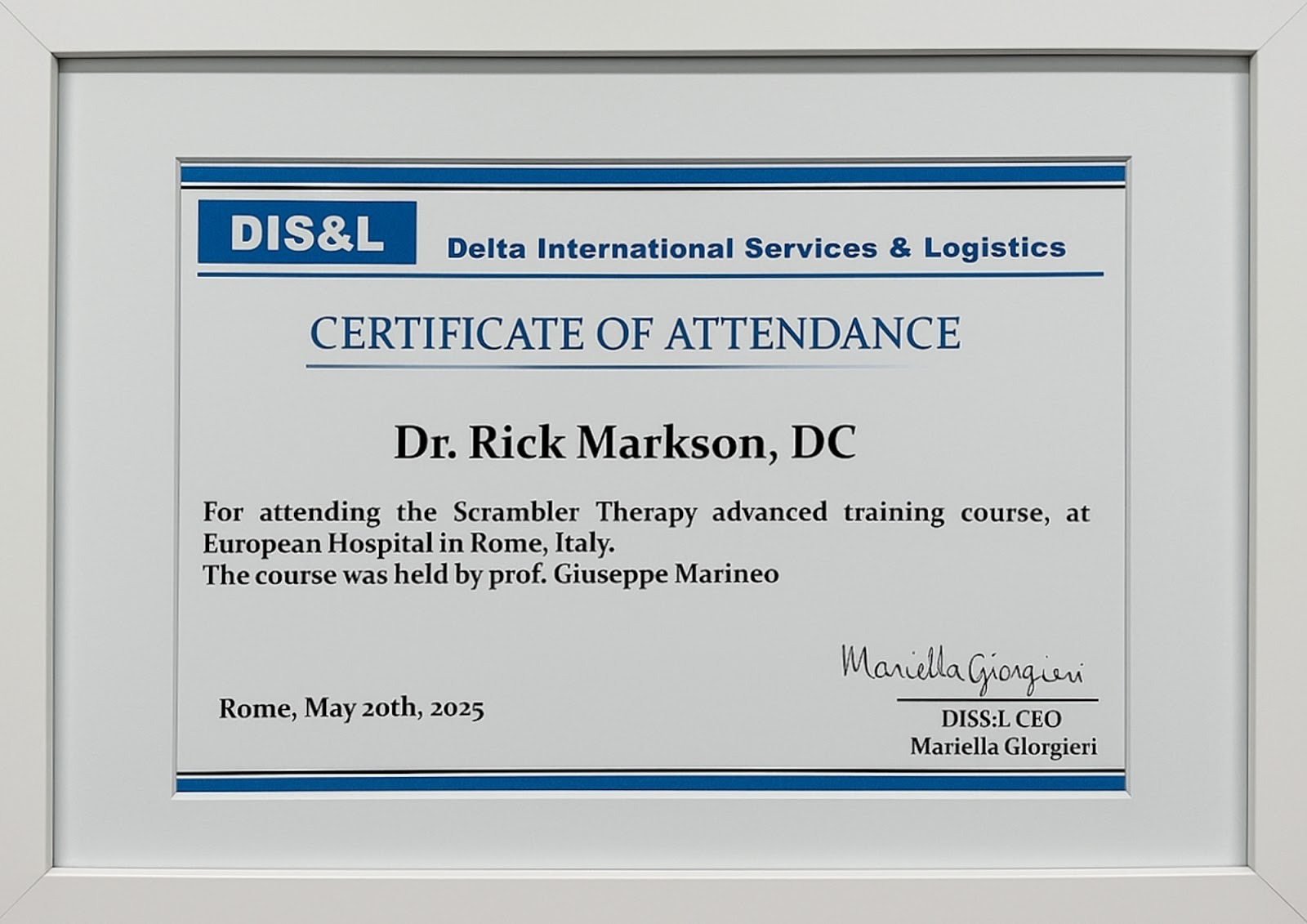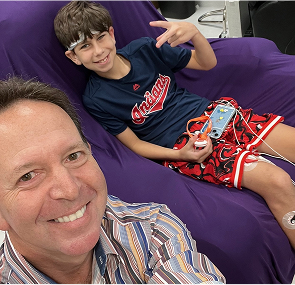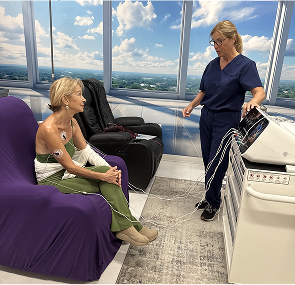Lifestyle Tips to Maximize Your Scrambler Therapy Results

Lifestyle significantly influences the effectiveness of Scrambler Therapy.
Scrambler Therapy aims to retrain nerve signals to reduce chronic pain. However, daily habits—such as diet, sleep, exercise, stress levels, and hydration—can either enhance or hinder its effects.
Behavioral choices impact pain modulation.
Patient compliance, emotional resilience, and treatment consistency affect how well the nervous system responds to therapy. The brain learns to reinterpret pain signals more efficiently when supported by healthy routines and a stable physiological environment.
Next, we explain how Scrambler Therapy works and how lifestyle integrates with its mechanism.
How Does Scrambler Therapy Work in Chronic Pain Management?
Scrambler Therapy interrupts chronic pain signals through electrostimulation.
It uses FDA-cleared devices that deliver electrical pulses to override nociceptor (pain receptor) signals and reprogram nerve communication. Unlike TENS, Scrambler Therapy simulates normal nerve input, not just blocking pain.
Neural reprogramming requires consistency and system support.
Scrambler Therapy effectiveness depends on how well your nervous system can adapt. Lifestyle plays a role in optimizing this adaptive process—referred to as neuroplasticity. Neural pathways heal faster when inflammation, stress, and fatigue are minimized.
Conditions treated by Scrambler Therapy include:
- Neuropathic pain
- Chemotherapy-induced peripheral neuropathy
- Post-surgical nerve pain
- Complex regional pain syndrome (CRPS)
Session Duration: Most protocols involve 10–12 sessions, with each lasting 30–45 minutes. Consistent attendance and lifestyle alignment maximize pain relief duration.
Next, we explore how your nutrition choices can amplify therapy effects.
What Foods Help Maximize Scrambler Therapy Benefits?
Anti-inflammatory diets reduce nerve irritation and support healing.
Inflammation affects pain sensitivity and signal transmission. Nutrition directly influences cytokine levels and immune modulation, which are central to chronic pain.
Best Foods to Eat During Scrambler Therapy:
- Omega-3 fatty acids: Salmon, chia seeds, flaxseeds – reduce cytokines
- Antioxidant-rich foods: Blueberries, spinach, kale – protect neural tissue
- Turmeric (curcumin): Reduces inflammatory enzymes like COX-2
- Low-glycemic carbs: Sweet potatoes, legumes – stabilize blood sugar
- Hydrating foods: Cucumbers, watermelon – support cellular hydration
Avoid high-sugar and ultra-processed foods
These increase inflammation markers like CRP and interfere with pain management.
Nutrient timing matters.
Eating balanced meals around therapy sessions can improve energy levels and cognitive responsiveness to neural retraining.
Next, we look at movement and its effect on Scrambler Therapy success.
How Does Exercise Support Scrambler Therapy?
Low-impact movement improves nerve health and therapy outcomes.
Exercise increases blood flow, enhances oxygen delivery to tissues, and supports neuroplastic changes. It reduces muscle tension, promotes proprioception, and triggers endorphins—natural painkillers.
Best Exercises During Scrambler Therapy:
- Gentle yoga: Enhances flexibility, parasympathetic tone
- Walking: Improves blood flow, mood, and joint mobility
- Swimming or aquatic therapy: Reduces joint pressure while activating muscles
- Stretching routines: Helps release fascia tension and improve posture
- Guided physical therapy: Focuses on injury-specific recovery
Movement schedules should align with energy levels.
Exercise too soon after a session may fatigue the nervous system. Optimal time: 4–6 hours post-treatment.
Next, we review how sleep patterns influence Scrambler Therapy outcomes.
Why Is Sleep Quality Important During Scrambler Therapy?
Deep sleep enhances neuroregeneration and pain reduction.
During REM and slow-wave sleep, the body releases growth hormones, supports tissue repair, and consolidates new neural pathways—crucial for the success of nerve retraining.
Sleep Tips for Therapy Optimization:
- Avoid blue light 2 hours before bed to stabilize melatonin
- Follow a consistent sleep schedule to align circadian rhythm
- Use sleep trackers to measure REM and deep sleep durations
- Lower cortisol levels in the evening with calming routines
- Keep the room cool and dark to optimize sleep architecture
Poor sleep increases pain sensitivity and delays recovery by elevating inflammation and disrupting autonomic balance.
Next, we look at how stress control affects Scrambler Therapy.
How Does Stress Impact Scrambler Therapy Benefits?
Chronic stress increases sympathetic activation and disrupts therapy response.
High cortisol levels interfere with nerve signaling and pain modulation. Stress contributes to the stress-pain loop, making therapy less effective.
Stress Reduction Techniques:
- Mindfulness meditation: Enhances vagus nerve activity and HRV
- Deep breathing: Regulates the autonomic nervous system
- Cognitive Behavioral Therapy (CBT): Improves emotional regulation
- Progressive muscle relaxation: Reduces physical tension
- Journaling: Supports cognitive unloading and clarity
Regular practice improves autonomic balance, which supports the body’s ability to interpret therapy inputs correctly.
Next, we discuss hydration and detox support during therapy.
Why Is Hydration Important During Scrambler Therapy?
Water intake directly affects nerve function and detoxification.
Hydration facilitates cellular signaling, electrolyte balance, and metabolic waste removal—all essential for healthy nerve communication.
Hydration & Detox Tips:
- Drink at least 2–3 liters of water daily (adjusted for body weight)
- Use electrolyte-rich drinks if exercising or sweating
- Incorporate herbal teas like ginger, nettle, or dandelion for lymph support
- Avoid excessive caffeine and alcohol, which dehydrate and stress the liver
Proper hydration reduces inflammatory by-products, enhances lymphatic drainage, and supports therapy-induced neural reprogramming.
Next, we explore how tracking your progress improves therapy effectiveness.
How to Track Progress During Scrambler Therapy?
Tracking helps identify therapy response curves and optimize adjustments.
Monitoring symptoms offers feedback on what’s working and what needs modification.
Tools to Use:
- Pain scale journals: Log daily pain levels and fluctuations
- Mobile health apps: Track sleep, mood, energy, pain triggers
- Wearable devices: Measure HRV, steps, sleep, stress response
- Weekly symptom summary logs: Document physical and emotional changes
Trend identification helps clinicians adjust the treatment plan, enhancing personalization and success rates.
Next, we look at the emotional and social factors influencing therapy results.
How Does Support & Mindset Influence Scrambler Therapy?
Positive mindset and social support increase Scrambler Therapy success.
Emotional resilience, optimism, and caregiver involvement create a healing environment. Self-efficacy plays a key role in compliance and motivation.
Ways to Strengthen Mindset:
- Join chronic pain support groups to share experiences
- Educate family or caregivers for better home support
- Practice positive self-talk to build resilience
- Seek mental health guidance to address emotional hurdles
- Engage in resilience training to strengthen coping capacity
Patients with strong support systems show higher engagement and lower dropout rates.
Next, we look at complementary therapies that enhance results.
Which Integrative Therapies Complement Scrambler Therapy?
Holistic treatments enhance the physiological and emotional readiness for Scrambler Therapy.
Recommended Integrative Approaches:
- Acupuncture: Stimulates meridian pathways and calms nervous system
- Massage therapy: Promotes fascia relaxation and blood circulation
- Chiropractic adjustments: Align spinal nerves and relieve tension
- Cupping: Supports lymph drainage and reduces muscle knots
- Essential oils (e.g., lavender, peppermint): Aid in emotional and physical relaxation
Integrative approaches enhance neural receptivity and create optimal conditions for nerve reprogramming.
Next, we highlight mistakes that could reduce Scrambler Therapy effectiveness.
What Mistakes Can Reduce Scrambler Therapy Benefits?
Inconsistency and unhealthy habits can counteract therapy gains.
Mistakes to Avoid:
- Skipping sessions – disrupts neural learning cycles
- Poor diet choices – increases inflammation and slows nerve recovery
- Ignoring mental health – heightens pain perception
- Neglecting hydration – reduces signal transmission efficiency
- Lack of exercise – weakens blood flow and neuroplasticity
Therapy noncompliance can lead to regression, flare-ups, and longer recovery timelines.
Now, we answer the most common questions about Scrambler Therapy.
FAQs – Answering Common Questions About Scrambler Therapy Benefits
How long does it take to feel Scrambler Therapy benefits?
Most patients feel noticeable relief by session 4–5, with full benefits after 10–12 sessions.
Can I continue physical activity during therapy?
Yes, but stick to low-impact exercises like walking, yoga, or stretching.
Are there foods that help Scrambler Therapy work better?
Yes. Anti-inflammatory foods such as salmon, berries, and turmeric reduce pain signals and enhance nerve healing.
Does Scrambler Therapy help all types of chronic pain?
It is most effective for neuropathic and nerve-related pain, such as diabetic neuropathy, CRPS, and chemotherapy-induced pain.
How do I know if Scrambler Therapy is working?
Track your pain levels, sleep quality, and mobility in a symptom journal to monitor changes session by session.
Experiencing Chronic Pain in South Florida?

Discover South Florida Scrambler Therapy is one of the nation’s leading clinics for noninvasive chronic pain relief, offering FDA-cleared Scrambler Therapy® for adults and children. Co-founded by Dr. Rick Markson, one of the few practitioners worldwide to receive advanced certification directly from the therapy’s inventor in Rome, our clinic delivers globally recognized expertise with compassionate, personalized care. If you or a loved one is living with treatment-resistant nerve pain, we invite you to schedule a consultation and explore a life beyond pain.
Recommended Reads:
📘 What is scrambler therapy?
📘 What to Expect During a Scrambler Session
📘 CRPS Pain Relief Without Drugs—Real Patient Stories
📘 Conditions that scrambler therapy can treat
Take the Next Step: Free Consultation at South Florida Scrambler

Every day counts when we suffer from chronic pain. South Florida Scrambler Therapy offers a free initial consultation to determine if Scrambler is right for you. Schedule Today:
- Speak directly with Dr. Rick Markson’s team
- Learn about treatment protocols and insurance
- Complete a customized treatment plan
- Start seeing results within days, not months
📞 Call Now or Visit website: www.southfloridascramblertherapy.com
📍 We serve Palm Beach, Fort Lauderdale, and Miami from our location at 100 NW 100th Ave, Plantation
You Can Follow Us through Our Social Media:
📸Instagram—Day-in-the-life stories from our patients
👍Facebook—Success journeys and community support
You deserve to laugh, and enjoy life without pain. The journey starts here.
Start Your Pain-Free Journey Today





.jpg)
